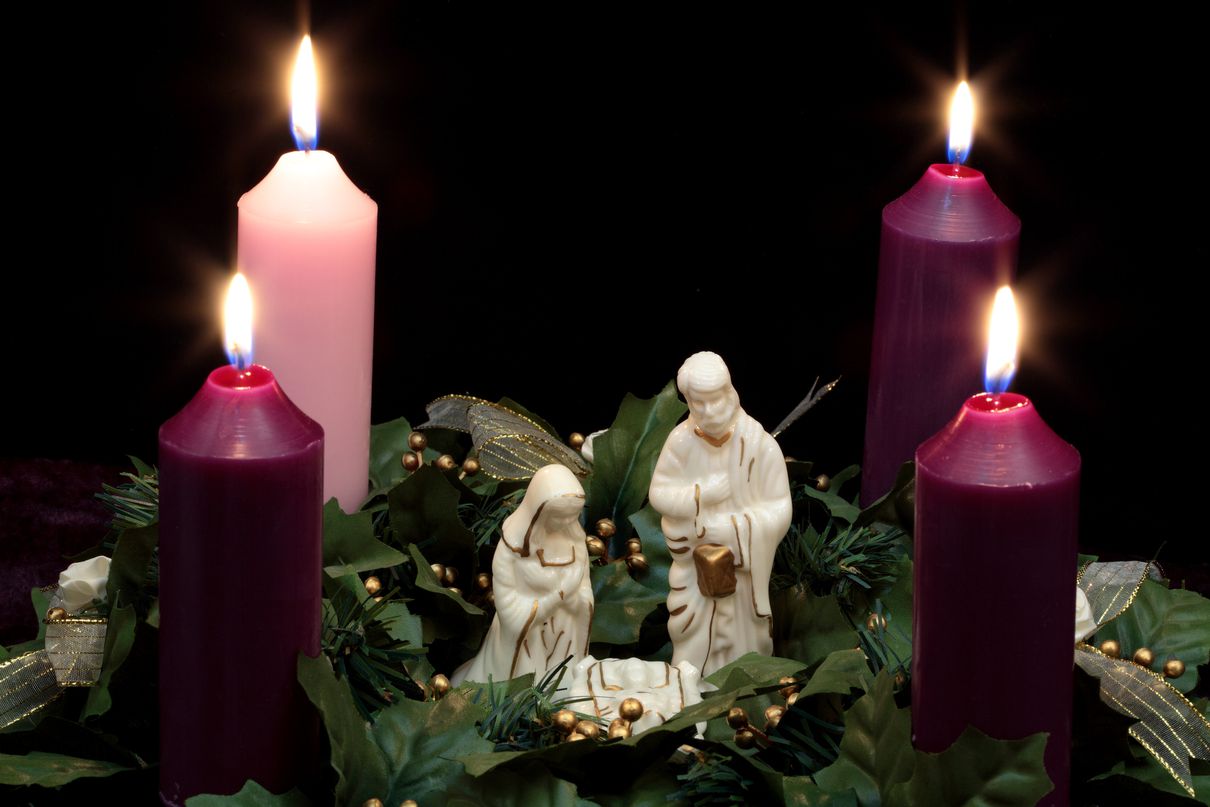What Is the Advent Wreath?
from learnreligions.com
by Mary Fairchild, updated September 7, 2020
 The Advent wreath is a meaningful tradition practiced by many Christians during the season of Advent. The custom is part of the spiritual preparations that believers make for the coming of Jesus Christ at Christmas.
What Is the Advent Wreath?
The Advent wreath is a meaningful tradition practiced by many Christians during the season of Advent. The custom is part of the spiritual preparations that believers make for the coming of Jesus Christ at Christmas.
What Is the Advent Wreath?The Advent wreath is a circular garland of evergreen branches representing eternity. On that wreath, four or five candles are typically arranged. Each candle represents an aspect of the spiritual preparation for the coming of the Lord, Jesus Christ. During the season of Advent, one candle on the wreath is lit each Sunday as a part of the Advent services. Families or other small groups of people give devotional readings while lighting the candles on the Advent wreath, adding a meaningful dimension to worship. Many families repeat the tradition at home as a way of deepening and making spiritual preparations more intimate and personal. History and Time of the Advent Wreath
The lighting of an Advent wreath is a custom that began in 16th-century Germany among Lutherans and Catholics. The original purpose of the wreath was to bring focus on Christmas rather than on Advent as a distinct season. In Western Christianity, Advent begins on the fourth Sunday before Christmas Day, or the Sunday which falls closest to November 30, and lasts through Christmas Eve, or December 24. The symbolism of Advent Wreath Candles
Set on the branches of the Advent wreath are four candles: three purple candles and one pink candle. A more modern tradition is to place a white candle in the center of the wreath. As a whole, these colored advent candles represent the coming of the light of Christ into the world. Each week of Advent on Sunday, a particular Advent candle is lit. Catholic tradition states that the four candles, representing the four weeks of Advent, each stand for one thousand years, to total the 4,000 years from the time of Adam and Eve until the birth of the Savior. (NOTE: The meaning of each candle may vary according to the liturgy chosen for the service. The following descriptions provide one set of interpretations.) Prophecy Candle
On the first Sunday of Advent, the first purple candle is lit. This candle is typically called the "Prophecy Candle" in remembrance of the prophets, primarily Isaiah, who foretold the birth of Christ:
Therefore the Lord himself will give you a sign: The virgin will conceive and give birth to a son, and will call him Immanuel.
(Isaiah 7:14)
This first candle represents hope or expectation in anticipation of the coming Messiah.
Bethlehem Candle(Isaiah 7:14)
On the second Sunday of Advent, the second purple candle is lit. This candle typically represents love. Some traditions call this the "Bethlehem Candle," symbolizing Christ's manger:
"This will be a sign to you: You will find a baby wrapped in cloths and lying in a manger."
(Luke 2:12, NIV)
Shepherds Candle(Luke 2:12, NIV)
On the third Sunday of Advent the pink, or rose-colored candle is lit. This pink candle is customarily called the "Shepherds Candle," and it represents joy:
And there were shepherds living out in the fields nearby, keeping watch over their flocks at night. An angel of the Lord appeared to them, and the glory of the Lord shone around them, and they were terrified. But the angel said to them, "Do not be afraid. I bring you good news that will cause great joy for all the people. Today in the town of David a Savior has been born to you; he is the Messiah, the Lord.
(Luke 2:8–11, NIV)
Angels Candle(Luke 2:8–11, NIV)
The fourth and last purple candle, often called the "Angels Candle," represents peace and is lit on the fourth Sunday of Advent.
Suddenly a great company of the heavenly host appeared with the angel, praising God and saying, "Glory to God in the highest heaven, and on earth peace to those on whom his favor rests."
(Luke 2:13–14, NIV)
Christ Candle(Luke 2:13–14, NIV)
On Christmas Eve, the white center candle is lit. This candle is called the "Christ Candle" and represents the life of Christ that has come into the world. The color white represents purity. Christ is the sinless, spotless, pure Savior. Those who receive Christ as Savior are washed of their sins and made whiter than snow:
"Come now, let us settle the matter," says the Lord. "Though your sins are like scarlet, they shall be as white as snow; though they are red as crimson, they shall be like wool."
(Isaiah 1:18, NIV)
Advent for Children and Families(Isaiah 1:18, NIV)
Celebrating with an Advent wreath during the weeks before Christmas is an excellent way for Christian families to keep Christ at the center of Christmas, and for parents to teach their children the true meaning of Christmas. This tutorial will teach you how to make your own Advent wreath. Another Advent tradition that can be very meaningful and fun for children is to celebrate with a Jesse Tree. This resource will help you learn more about the Jesse Tree Advent custom.
Sources
Holydays and Holidays. In Mastering Worship (p. 136). Religious and Theological Abstracts. Myerstown, PA: Religious and Theological Abstracts.